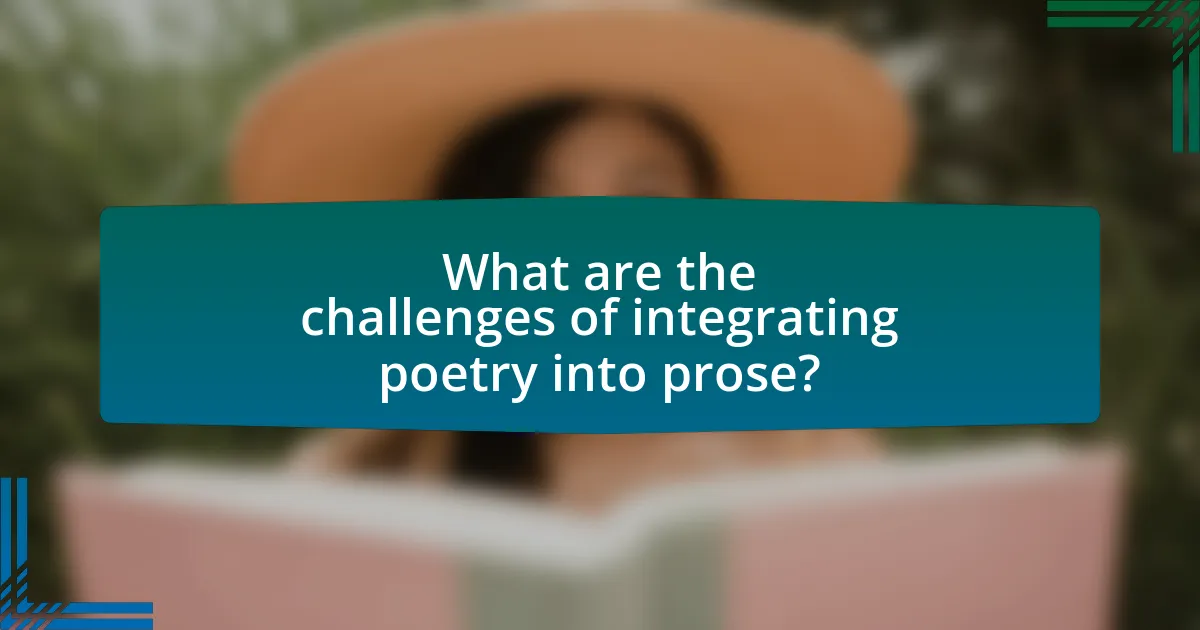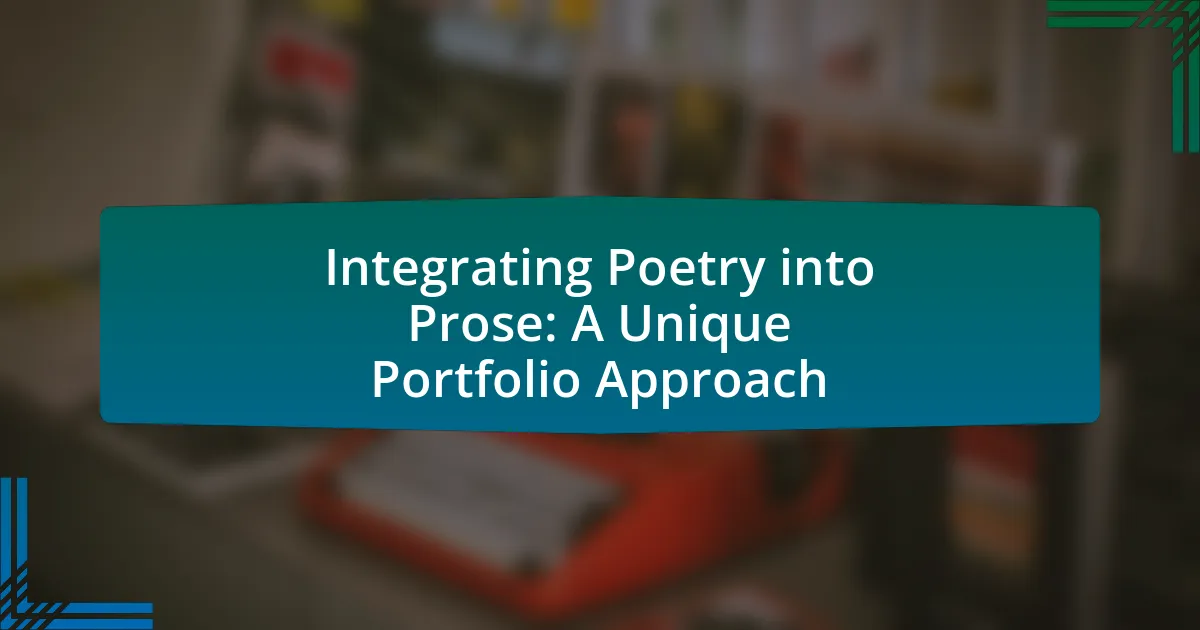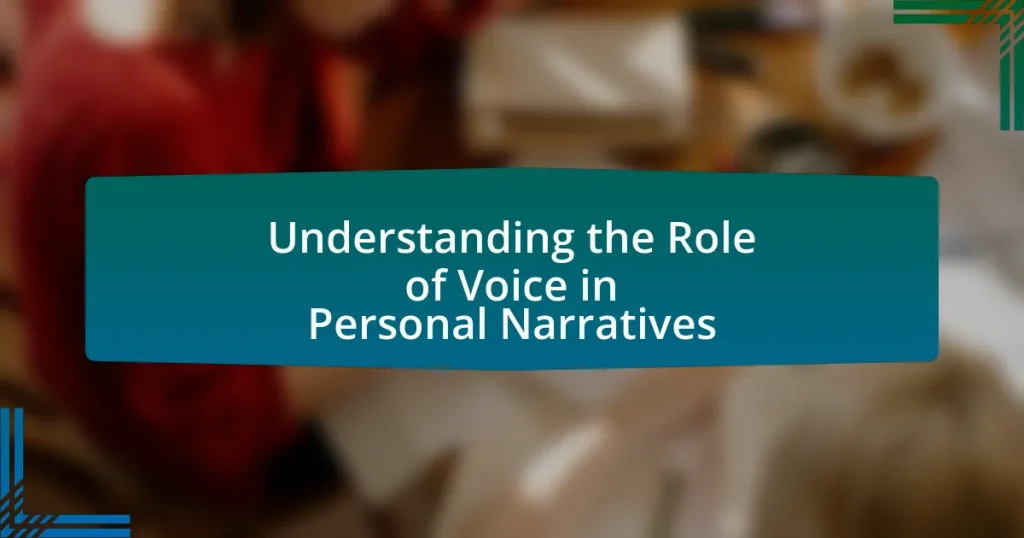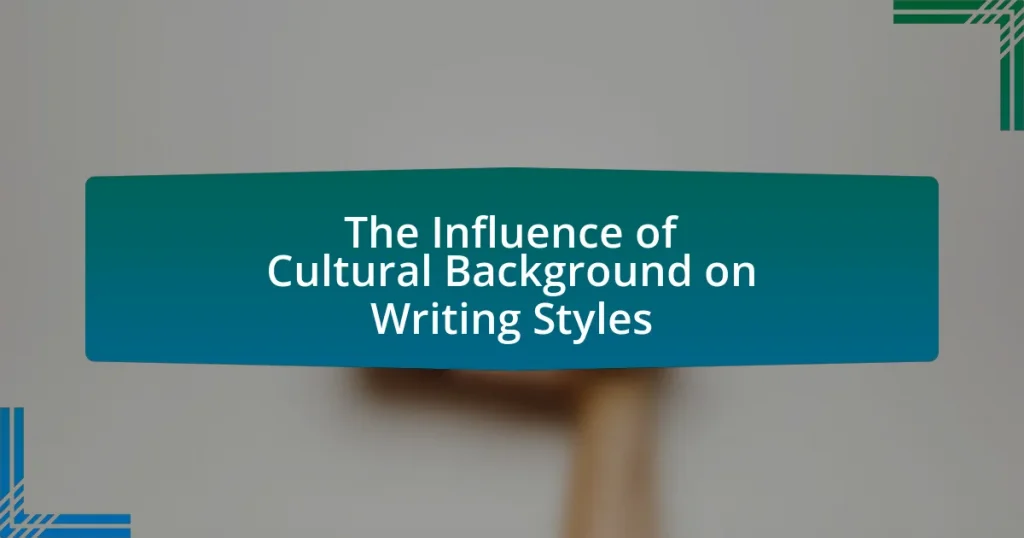Integrating poetry into prose involves blending poetic elements such as imagery, rhythm, and metaphor within prose narratives to enhance emotional depth and aesthetic quality. This article explores how poetry can enrich prose writing, highlighting specific poetic devices and their impact on narrative style. It also discusses the challenges writers face when integrating these forms, strategies to maintain clarity, and the importance of audience consideration. Additionally, the article provides examples of successful integration by notable authors and offers best practices for creating a portfolio that effectively showcases the interplay between poetry and prose.

What does it mean to integrate poetry into prose?
Integrating poetry into prose means blending poetic elements, such as imagery, rhythm, and metaphor, within a prose narrative to enhance emotional depth and aesthetic quality. This technique allows writers to evoke feelings and create vivid imagery, enriching the reader’s experience. For instance, authors like Virginia Woolf and James Joyce have effectively used this integration to elevate their prose, demonstrating how poetic language can transform ordinary storytelling into a more immersive and evocative form.
How can poetry enhance prose writing?
Poetry can enhance prose writing by infusing it with rhythm, imagery, and emotional depth. The use of poetic devices such as metaphor, simile, and alliteration can create vivid imagery that engages readers more effectively than straightforward prose. For instance, authors like Virginia Woolf and James Joyce have demonstrated how lyrical language can elevate narrative prose, making it more evocative and immersive. Research indicates that prose enriched with poetic elements can evoke stronger emotional responses, as seen in studies on literary appreciation, which show that readers often connect more deeply with texts that employ poetic techniques.
What specific poetic devices can be used in prose?
Specific poetic devices that can be used in prose include imagery, metaphor, simile, alliteration, and personification. Imagery creates vivid sensory experiences, enhancing the reader’s connection to the text. Metaphors and similes draw comparisons that deepen understanding and evoke emotions, while alliteration adds a musical quality that can enhance rhythm and flow. Personification attributes human characteristics to non-human elements, making abstract concepts more relatable. These devices enrich prose by adding layers of meaning and emotional depth, as evidenced by authors like Virginia Woolf and Gabriel García Márquez, who effectively integrate these techniques into their narrative styles.
How does the rhythm of poetry influence prose style?
The rhythm of poetry significantly influences prose style by introducing musicality and cadence that enhance the reading experience. This rhythmic quality can create a more engaging narrative flow, allowing prose to evoke emotions and imagery similar to poetry. For instance, authors like Virginia Woolf and James Joyce employed rhythmic techniques in their prose to mirror the fluidity and depth found in poetry, demonstrating that rhythm can elevate the emotional resonance and aesthetic appeal of written language.
Why is a unique portfolio approach beneficial?
A unique portfolio approach is beneficial because it allows for the integration of diverse creative expressions, enhancing the overall impact of the work. This method fosters innovation by combining different styles and genres, which can attract a wider audience and stimulate deeper emotional responses. Research indicates that interdisciplinary approaches in creative fields often lead to more engaging and memorable experiences, as seen in studies on cross-genre storytelling that highlight increased audience retention and satisfaction.
What are the key elements of a unique portfolio approach?
The key elements of a unique portfolio approach include a diverse range of works, a cohesive theme, and a personal voice. A diverse range of works showcases various styles and formats, allowing for creative expression and versatility. A cohesive theme ties the pieces together, providing a clear narrative or concept that enhances the overall impact. A personal voice reflects the individual’s unique perspective and style, making the portfolio distinct and memorable. These elements collectively contribute to a portfolio that stands out in both artistic and professional contexts.
How does a portfolio showcase the integration of poetry and prose?
A portfolio showcases the integration of poetry and prose by presenting a curated collection of works that blend the two forms, highlighting their thematic and stylistic connections. This integration is evident through the use of poetic devices such as imagery, metaphor, and rhythm within prose narratives, creating a layered reading experience. For example, a portfolio may include prose pieces that incorporate poetic language or structure, demonstrating how the emotional depth of poetry enhances storytelling. Additionally, the juxtaposition of standalone poems alongside prose excerpts allows for a comparative analysis, illustrating how each form can inform and elevate the other, ultimately enriching the reader’s understanding of both genres.

What are the challenges of integrating poetry into prose?
Integrating poetry into prose presents challenges such as maintaining coherence and ensuring that the poetic elements enhance rather than disrupt the narrative flow. The juxtaposition of poetic language, which often relies on rhythm, meter, and imagery, can clash with the more straightforward structure of prose, potentially confusing readers. Additionally, balancing the emotional depth of poetry with the narrative demands of prose requires careful consideration to avoid overwhelming the reader or diluting the impact of both forms. These challenges are supported by literary analysis, which indicates that successful integration often hinges on the writer’s ability to harmonize distinct stylistic elements while preserving the integrity of both poetry and prose.
How can writers overcome these challenges?
Writers can overcome challenges in integrating poetry into prose by employing structured techniques such as thematic alignment, rhythmic consistency, and careful editing. Thematic alignment ensures that the poetic elements enhance the narrative rather than distract from it, creating a cohesive reading experience. Rhythmic consistency helps maintain the flow between prose and poetry, allowing for a seamless transition that engages readers. Additionally, careful editing is crucial; it allows writers to refine their work, ensuring that the poetic elements serve a purpose and resonate with the overall message. These strategies are supported by successful examples in literature, where authors like Virginia Woolf and Pablo Neruda have effectively blended prose and poetry, demonstrating that thoughtful integration can elevate the narrative.
What techniques can help maintain clarity while integrating poetry?
To maintain clarity while integrating poetry, one effective technique is to use clear transitions between prose and poetic elements. This approach ensures that readers can easily follow the narrative flow without confusion. For instance, employing visual cues such as line breaks or italics can signal shifts from prose to poetry, helping to delineate different forms of expression. Additionally, maintaining a consistent tone throughout both prose and poetry aids in preserving clarity, as it allows readers to engage with the text without being distracted by abrupt changes in style. Research indicates that clarity in writing enhances reader comprehension, which is crucial when blending different literary forms.
How can feedback improve the integration process?
Feedback can significantly enhance the integration process by providing insights into the effectiveness of blending poetry and prose. This input allows creators to identify strengths and weaknesses in their work, enabling them to refine their techniques and improve overall coherence. For instance, studies have shown that iterative feedback loops in creative writing lead to higher quality outputs, as they encourage revisions that align more closely with audience expectations and artistic goals. By actively incorporating feedback, writers can create a more seamless and impactful integration of poetic elements within prose, ultimately enriching the reader’s experience.
What role does audience play in this integration?
The audience plays a crucial role in the integration of poetry into prose by influencing the stylistic choices and thematic elements of the work. Understanding the audience’s preferences and expectations allows writers to tailor their integration methods, ensuring that the poetic elements resonate effectively within the prose context. For instance, research indicates that audience engagement can enhance emotional responses, making the integration more impactful. This is supported by studies showing that readers often connect more deeply with texts that reflect their experiences and emotions, thereby validating the importance of audience consideration in literary integration.
How can understanding the audience shape the integration of poetry and prose?
Understanding the audience shapes the integration of poetry and prose by allowing writers to tailor their language, themes, and emotional resonance to meet the expectations and preferences of their readers. When writers analyze their audience’s demographics, interests, and cultural backgrounds, they can select poetic devices and prose styles that enhance engagement and comprehension. For instance, a study by the National Endowment for the Arts found that audiences with a strong appreciation for lyrical language respond positively to prose that incorporates poetic elements, such as rhythm and imagery, thereby enriching the narrative experience. This targeted approach not only fosters a deeper connection between the text and the reader but also increases the likelihood of the work being impactful and memorable.
What are the potential reactions from readers to this integration?
Readers may react positively to the integration of poetry into prose, appreciating the enhanced emotional depth and artistic expression it brings. This integration can evoke a sense of connection and resonance, as poetry often distills complex emotions into concise language, enriching the overall narrative. Additionally, readers might find the unique stylistic blend refreshing and innovative, potentially attracting a broader audience who values both forms of writing. Studies in literary engagement indicate that diverse narrative techniques can increase reader interest and satisfaction, supporting the notion that such integration can lead to favorable reactions.

What are some examples of successful integration of poetry into prose?
Successful integration of poetry into prose can be seen in works like “The Sound and the Fury” by William Faulkner, where stream-of-consciousness narrative incorporates lyrical passages, enhancing emotional depth. Another example is “Beloved” by Toni Morrison, which blends poetic language with prose to evoke the haunting memories of slavery. Additionally, “The Brief Wondrous Life of Oscar Wao” by Junot Díaz features footnotes that include poetic elements, enriching the storytelling experience. These examples demonstrate how poetry can elevate prose by adding layers of meaning and emotional resonance.
How have notable authors achieved this integration?
Notable authors have achieved the integration of poetry into prose by employing lyrical language, rhythmic structures, and vivid imagery within their narratives. For instance, Virginia Woolf’s use of stream-of-consciousness in “To the Lighthouse” blends poetic elements with prose, creating a fluid narrative that captures the characters’ inner thoughts and emotions. Similarly, authors like Pablo Neruda and Rainer Maria Rilke have seamlessly woven poetic forms into their prose works, enhancing the emotional depth and aesthetic quality of their storytelling. This integration not only enriches the reading experience but also allows for a more nuanced exploration of themes, as seen in the works of these authors.
What specific works exemplify the blend of poetry and prose?
Specific works that exemplify the blend of poetry and prose include “The House of Leaves” by Mark Z. Danielewski, “The Collected Poems of Emily Dickinson” interspersed with prose commentary, and “The Waves” by Virginia Woolf. “The House of Leaves” utilizes unconventional formatting and narrative styles that merge poetic elements with a prose-driven story, creating a unique reading experience. Emily Dickinson’s collection often features prose annotations that provide context and interpretation, enhancing the poetic text. Virginia Woolf’s “The Waves” is structured as a series of poetic monologues that flow into prose, blurring the lines between the two forms. These works demonstrate how the integration of poetry and prose can create innovative literary experiences.
How can these examples inspire new writers?
These examples can inspire new writers by demonstrating the seamless integration of poetic elements into prose, enhancing emotional depth and creativity. Writers can observe how rhythm, imagery, and metaphor elevate narrative quality, making their work more engaging. For instance, authors like Virginia Woolf and James Joyce effectively employed lyrical language within their prose, showcasing that blending genres can lead to innovative storytelling. This approach not only broadens a writer’s stylistic range but also encourages experimentation, fostering a unique voice that resonates with readers.
What are best practices for creating a portfolio that integrates poetry and prose?
To create a portfolio that effectively integrates poetry and prose, one should focus on thematic coherence and stylistic harmony. Thematic coherence ensures that both forms of writing explore similar subjects or emotions, creating a unified narrative. For instance, a portfolio might center around themes of love, loss, or nature, allowing the poetry and prose to complement each other. Stylistic harmony involves maintaining a consistent voice and tone throughout the pieces, which can be achieved by using similar imagery or language patterns.
Additionally, including transitional pieces, such as prose poems or lyrical essays, can bridge the gap between poetry and prose, enhancing the overall flow. A well-structured layout that visually distinguishes between the two forms while maintaining a cohesive design can also improve readability and engagement. These practices are supported by successful portfolios from established writers who have effectively blended poetry and prose, demonstrating that a thoughtful approach can yield a compelling and artistic collection.
How should writers select pieces for their portfolio?
Writers should select pieces for their portfolio by focusing on showcasing a diverse range of their best work that highlights their unique voice and skills. This selection process involves choosing pieces that demonstrate proficiency in various styles, themes, and formats, particularly those that integrate poetry into prose, as this approach can illustrate creativity and versatility. For instance, including a blend of narrative essays, lyrical prose, and poetic forms can effectively showcase a writer’s ability to engage readers through different literary techniques. Additionally, writers should consider the relevance of each piece to their target audience or market, ensuring that the selected works align with the interests and expectations of potential clients or publishers.
What format works best for presenting integrated works?
The best format for presenting integrated works, particularly in the context of combining poetry and prose, is a portfolio format. This approach allows for a cohesive presentation of various pieces, showcasing the interplay between poetic and prose elements. Portfolios enable the inclusion of visual elements, annotations, and contextual explanations that enhance the reader’s understanding of the integrated works. Research indicates that portfolios facilitate a deeper engagement with the material, as they allow for a nonlinear exploration of themes and styles, making them effective for presenting complex literary integrations.
What tips can help writers effectively integrate poetry into prose?
Writers can effectively integrate poetry into prose by using lyrical language and rhythm to enhance emotional depth. This technique allows prose to resonate more profoundly with readers, as seen in works like “The God of Small Things” by Arundhati Roy, where poetic elements enrich the narrative. Additionally, incorporating imagery and metaphor from poetry can create vivid scenes and evoke strong emotions, making the prose more engaging. For instance, the use of sensory details in prose can mirror the evocative nature of poetry, drawing readers into the experience. By blending these elements, writers can create a seamless fusion that elevates their storytelling.



